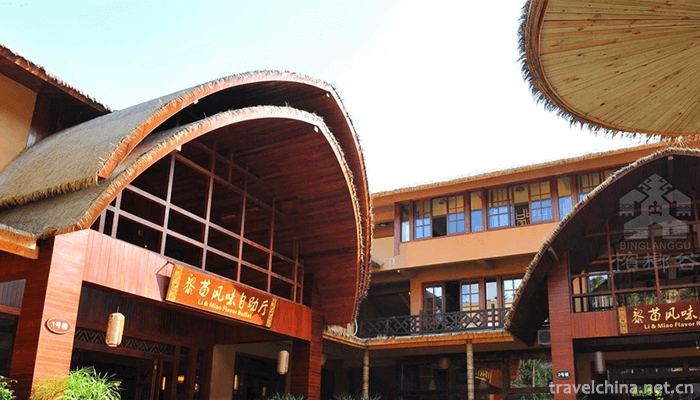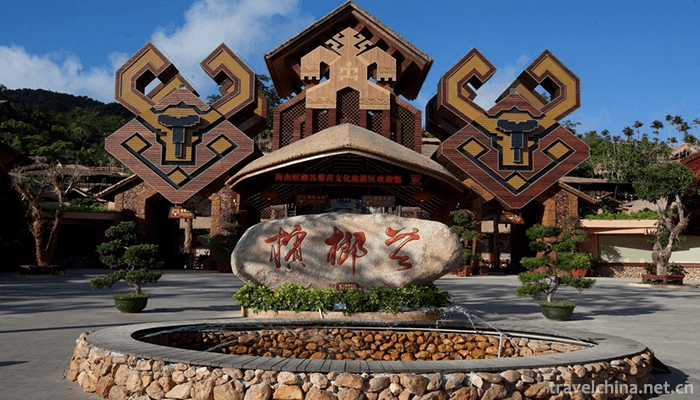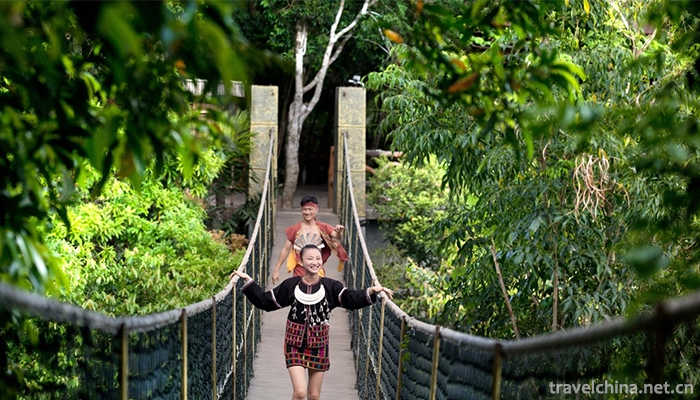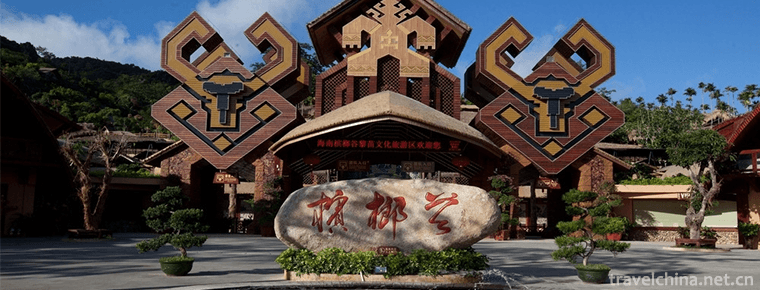Betelnut Valley Limiao Cultural Tourist Area
Hainan Betelnut Valley Limiao Cultural Tourist Area was established in 1998. It is located in the Ganshiling Nature Reserve at the junction of Baoting County and Sanya City. The scenic spot is situated in the beautiful areca nut forest sea of more than 10,000 pavilions and pavilions. It is also located in the tropical rain forest with tall ancient trees and vines. It has a planned area of more than 5,000 mu, 26 kilometers away from the coast of Yalong Bay and 28 kilometers away from the center of Sanya City.
Betelnut Valley is named for its forests overlapping on both sides and a few kilometres of Betelnut Valley in the middle. The scenic spot is composed of seven cultural experience areas: non-legacy village, Ganshili village, rainforest Miao village, field Lijia, large-scale live performance of betel nut Guyun, orchid cabin and Limiao delicious food street, with beautiful scenery. Ten national intangible cultural heritages are also displayed in the scenic spot. Among them, "the traditional spinning, dyeing, weaving and embroidery skills of Li nationality" is listed in the list of intangible cultural heritages urgently in need of protection by UNESCO. Betelnut Valley is also one of the main venues for the traditional "March 3" and "Qixi Water Playing Festival" of Li and Miao nationalities in Hainan. Cultural charm is the "living fossil" of Hainan's national culture.
In July 2015, the Betelnut Valley was awarded the national AAAAA-level tourist attraction title. As the first national cultural 5A-level scenic spot in China, the Betelnut Valley was also the national intangible cultural heritage production protection base and the top ten best film shooting base. It was awarded the "National Model of National Unity and Progress" by the Ministry of Culture and the Ministry of Agriculture of the State Council, respectively. Collective, National Key Cultural Export Projects, National Five-star Enterprises of Leisure Agriculture and Rural Tourism, etc. are many national honors. Hainan Betelnut Valley Limiao Cultural Tourist Area, adhering to the mission of "excavating, protecting, inheriting, promoting Hainan Limiao Culture and making it alive and well", has reappeared to the world the civilization of Hainan for thousands of years, and is the inheritor and innovator of Hainan Aboriginal culture.
Major attractions and projects
Centennial Guli Village Cultural Experience Zone
Experience the four thematic museums of Hainan aborigines in non-legacy villages: non-woven museum, hemp spinning museum, cotton spinning Museum and dragon quilt museum. Place yourself in the ancient Li tribe in Ganshili village for a century and experience being a real Li family.
Rainforest Miaozhai Cultural Experience Zone
Go to Miaozhai for a glass of wine, listen to a song of Miaoling flying, watch a thrilling performance of "Upper Daoshan and Lower Fire Sea", experience the ancient embroidery skills of Miao dyeing and seedling, and then bring a pack of traditional Miao medicines specially for rheumatism. It's worth it!
Large-scale live performance experience area of betel nut Guyun
Beautiful dancing, beautiful ballads, ancient legends and eternal history are all skillfully integrated in the dense singing and dancing performances, making people linger and forget to return.
Limiao Food Culture Experience Zone
In the Polonian family, a mouthful of crisp and sweet betel nut opens the taste bud journey; in the Lijia Food Street, tasting pure Lijia snacks... Green food from nature, challenges the mountain game on the tip of tongue, the idea in reason, the unexpected recall, Bolon! uuuuuuuuuuuu
Miaojia Orchid Cabin Residence Experience Zone
By the side of the hill, the rain shuttle is like a curtain; listen to the sounds of frogs in the fields, weave the starry dream of Li Jia, turn off the power supply, and build the dream rainforest. In the high-altitude slippery rope, riding the dream of flying in the wind, crossing the obstacles of trouble, experience the pleasure of speed and passion!
Lijia Pastoral Landscape Experience Area
Looking up, the ink dye of mountains and peaks; looking down, the dim boat house. Farming in the mountains, in the fields, in the Jianjian; Agricultural food in vegetables, in the fields, in the heart. Forget the world's troubles, leisurely Li family, reclusive pastoral






-
1.Linhe Yellow River National Wetland Park Inner Mongolia
Inner Mongolia Linhe Yellow River National Wetland Park is located in Linhe District, Bayannaoer City, Inner Mongolia Autonomous Region, with a total area of 4637.6 hectares. The functional zoning map
Time 2018-12-26 -
2.Shigu Academy
Shigu Academy, located in Shigu Mountain, Shigu District, Hengyang City, an important city in central and southern Hunan Province, is the birthplace of Huxiang
Time 2019-02-08 -
3.One Man show
A kind of folk art. It is usually performed by one or two or three people. It is lively and funny, close to northern crosstalk. It is popular in Shanghai, Hangzhou and other places.
Time 2019-04-28 -
4.Lhasa nun Ma
Lhasa Bauma refers to a comprehensive music and dance art style which has a huge structure and contains poems, songs, dances and music, which is spread in Lhasa, Shigaze and Jiangzi of Tibet.
Time 2019-05-10 -
5.Xujiaquan
Xujiaquan, a traditional boxing method, originated in Tongji Village, Xintai City, Shandong Province. Xujiaquan originated in Yongzheng Period of Qing Dynasty and was created by Xu Shengcai, Gaozu of
Time 2019-07-09 -
6.Production Techniques of Yixing Purple Sand Pottery
Yixing Purple Sand Pottery Manufacturing Techniques, Dingshu Town, Yixing City, Jiangsu Province, local folk traditional pottery making techniques, one of the national intangible cultural heritage.
Time 2019-07-12 -
7.Legend of Yongding River
Yongding River legend is one of the local folklores in Beijing. Among many legends, the legend of river blocking is representative; the legend of Shijing Mountain and Shijing Mountain; the legend of b
Time 2019-07-14 -
8.The eldest son drum book
The eldest son drum book is the traditional art of rap and singing in Shanxi Province. Changzi County is known as the "Town of Quyi", which has a long history as well as a wide variety of Qu
Time 2019-07-25 -
9.Zhuxian Town Wood Print New Year Picture
Zhuxianzhen Wood Engraving New Year Picture is one of the ancient Chinese traditional crafts. As the originator of Chinese woodcut New Year pictures, is mainly distributed in Kaifeng, Zhuxian Town and
Time 2019-08-10 -
10.Zhuang Drama
Zhuang Opera, a local traditional drama in Guangxi Zhuang Autonomous Region, is one of the national intangible cultural heritage.
Time 2019-08-16 -
11.down the mountain Yao Bu Yao Mai Cai Tik Tok Songs 2020 Hot Songs
"Down the mountain" is composed by Zhu bin. Yao Bu Yao Mai Cai to sing. It was released on November 22, 2019
Time 2020-05-21 -
12.Needlework of Chinese embroidery
Category: random needling, straight needling, disc needling, trowel needling, grabbing needling, flat needling, scattered wrong needling, weaving embroidery, applying needling, auxiliary needling, variant embroidery
Time 2020-12-12